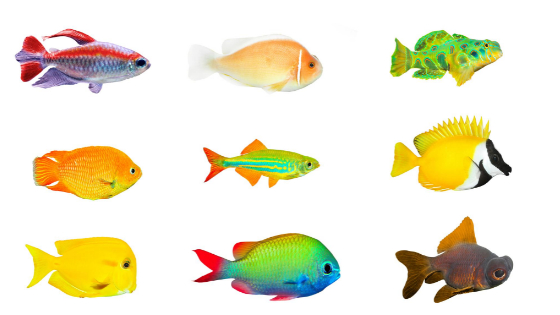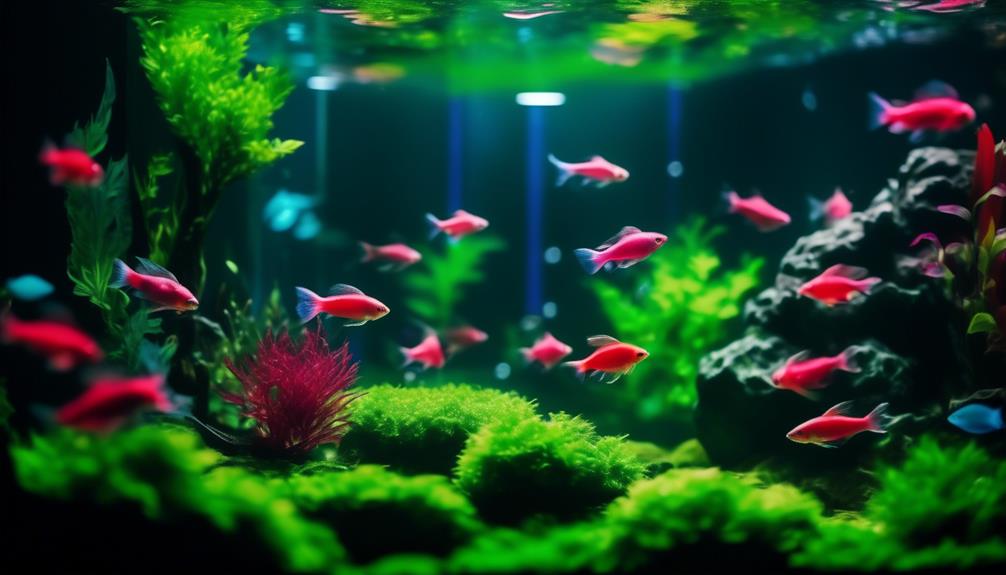
Have you ever marveled at the mesmerizing allure of Rasboras? With their shimmering colors and serene demeanor, these minnow-like freshwater fish possess an undeniable charm.
But there is more to Rasboras than meets the eye. As you delve into their world, you will uncover a wealth of fascinating characteristics, from their adaptability to various tank conditions to their non-aggressive nature.
But that’s not all, as we explore their feeding habits, breeding tendencies, and suitable tank mates, you will find yourself captivated by the hidden wonders of these enchanting creatures.
So, prepare to embark on a remarkable journey of discovery, where the secrets of Rasboras await your eager exploration.
Key Takeaways
- Rasboras are non-aggressive freshwater fish that require a medium-sized aquarium of around 30 gallons.
- They are adaptable to a wide range of water conditions and can live for up to ten years with proper care.
- Suitable tank mates for Rasboras include tetras, danios, white cloud minnows, plecos, platys, swordtails, guppies, and mollies.
- Rasboras are omnivores and should be fed a mixed diet of flake-based foods and live foods, such as blood worms and tubifex worms.
Characteristics of Rasboras
Rasboras, a family of minnow-type freshwater fish, possess several distinctive characteristics that make them fascinating additions to any aquarium. These small fish are found in freshwater habitats and have a non-aggressive temperament. They require a medium-sized aquarium, around 30 gallons, and can live for up to ten years with proper care.
Rasboras are adaptable to a wide range of water conditions and are suited for beginner aquarists. They’re hardy and easy to care for, making them a popular choice among fish enthusiasts. Additionally, rasboras are omnivores and can be fed a mixed diet of flake-based foods and live foods such as blood worms and tubifex worms.
Their small size and beautiful colors make them a delightful addition to any aquatic environment.
Suitable Tank Mates for Rasbora
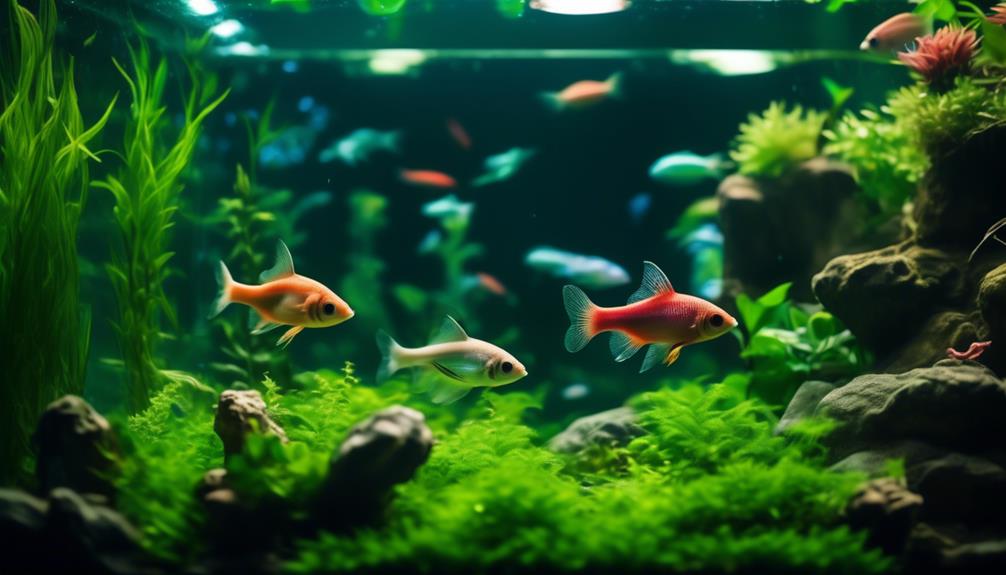
When considering suitable tank mates for rasboras, it’s important to choose compatible species that will thrive together in the aquarium environment. Rasboras are peaceful fish that prefer to be in small groups, so it’s best to avoid aggressive or territorial species.
Tetras, danios, and white cloud minnows are all good choices for tank mates, as they’ve similar water and dietary requirements. Plecos can also be suitable tank mates, as they help keep the aquarium clean by eating algae.
Additionally, platys, swordtails, guppies, and mollies can coexist peacefully with rasboras. Remember to provide ample hiding places and open swimming spaces for all the fish in the tank.
Difficulty of Care for Rasbora
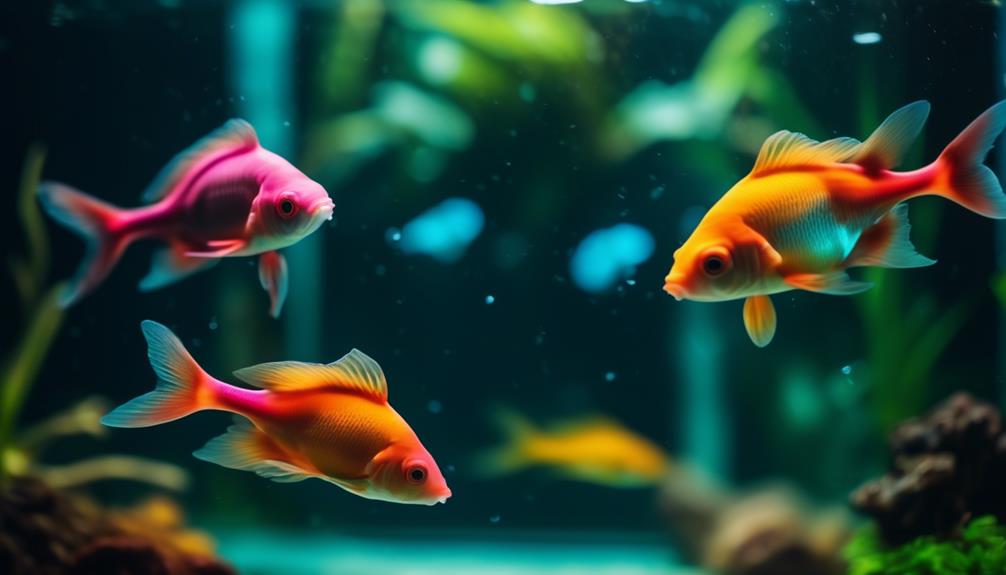
To properly care for rasboras, it’s important to understand the level of difficulty associated with their care. Here are some key points to consider:
- General Care:
- Monthly care is suited for beginner aquarists.
- Rasboras are hardy and easy to care for.
- They can live for up to ten years with proper care.
- They’re adaptable to a wide range of water conditions.
- Rasboras require large, open swimming spaces in the aquarium.
- Feeding:
- Rasboras are omnivores.
- They can be fed a mixed diet of flake-based foods and live foods.
- Live foods include blood worms and tubifex worms.
- Proper nutrition is important for their health and well-being.
- Feed them in small portions multiple times a day.
Feeding Rasbora
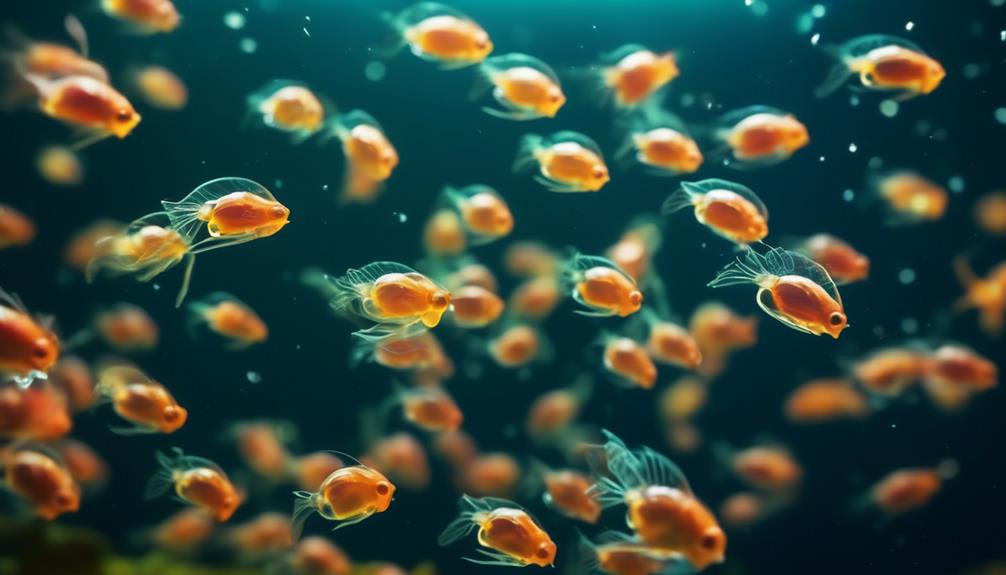
Feeding rasboras requires providing a balanced diet consisting of flake-based and live foods. As omnivores, rasboras can be fed a mixed diet to ensure their nutritional needs are met.
Flake-based foods can serve as their staple diet, while live foods such as blood worms and tubifex worms can be offered as occasional treats. It’s important to prioritize their health and well-being by providing them with proper nutrition.
Therefore, feeding them in small portions multiple times a day is recommended. This will help prevent overfeeding and maintain the water quality in the aquarium.
Breeding Rasbora
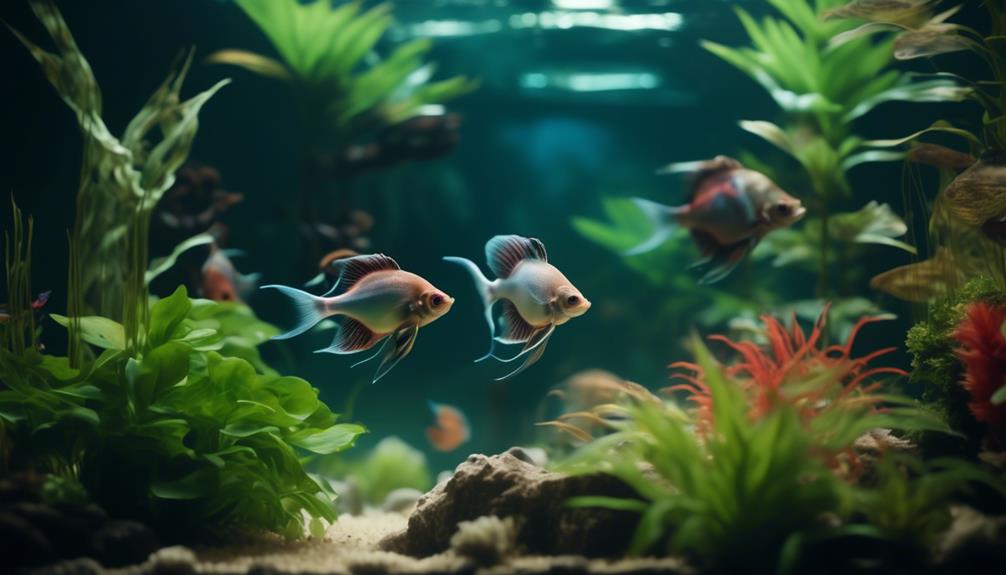
Breeding rasboras is a relatively straightforward process that can be accomplished with the right conditions and preparation. To successfully breed rasboras, there are a few key factors to consider:
- Tank setup:
- Use a separate breeding tank with heavily planted aquarium plants.
- Provide floating plants to create hiding spots for the eggs.
- Water conditions:
- Maintain a temperature between 75-82°F (24-28°C).
- Keep the water slightly acidic, with a pH level of 6-7.
- Breeding behavior:
- Introduce a small group of males and females to the breeding tank.
- Observe the males’ courtship behavior, such as flaring fins and chasing females.
- Egg care:
- After spawning, remove the adults from the breeding tank to prevent them from eating the eggs.
- Monitor the eggs closely for signs of fungus or disease.
Habitat and Environmental Requirements
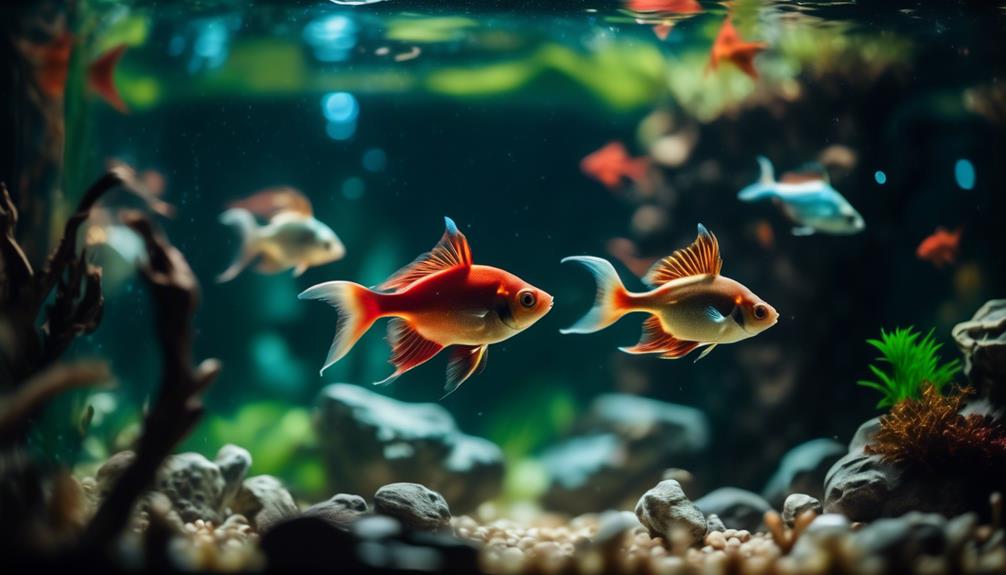
Now let’s explore the habitat and environmental requirements necessary for successfully keeping and caring for rasboras in your aquarium. Rasboras thrive in freshwater habitats and require a medium-sized aquarium, around 30 gallons, to accommodate their active nature. They have a non-aggressive temperament, making them suitable tank mates for tetras, danios, white cloud minnows, plecos, platys, sword-tails, guppies, and mollies. Rasboras are hardy and easy to care for, making them ideal for beginner aquarists. They can adapt to a wide range of water conditions, but they require large, open swimming spaces in the aquarium. When it comes to feeding, rasboras are omnivores and should be fed a mixed diet of flake-based foods and live foods such as blood worms and tubifex worms. Proper nutrition is important for their health and well-being, so feed them in small portions multiple times a day. Overall, rasboras are a fascinating addition to any aquarium, and with the right habitat and environmental conditions, they can thrive and bring beauty to your aquatic world.
| Habitat and Environmental Requirements | |
|---|---|
| 1 | Freshwater habitats |
| 2 | Medium-sized aquarium (30 gallons) |
| 3 | Large, open swimming spaces |
Common Species of Rasboras
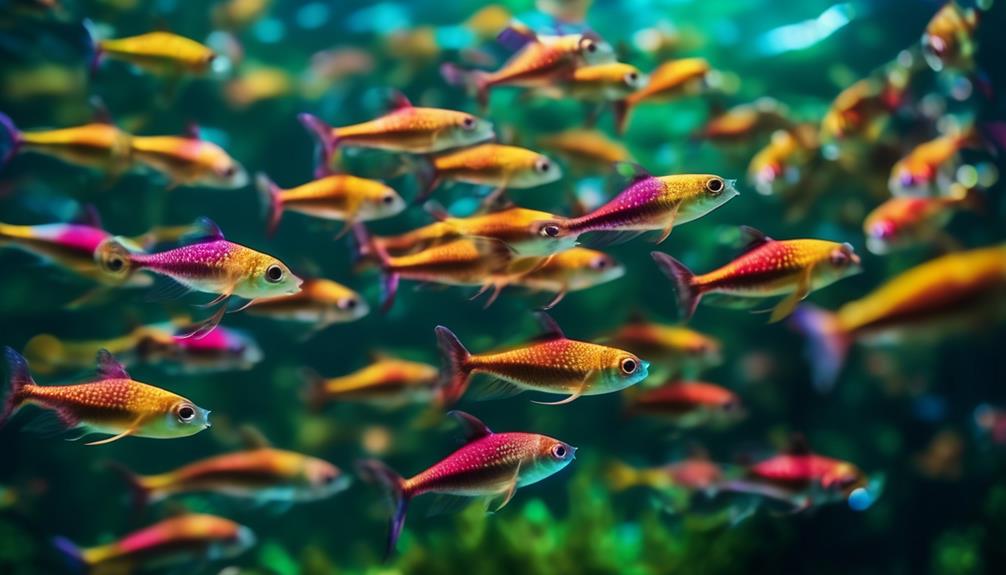
There are several common species of rasboras that make excellent additions to your aquarium. When considering which rasboras to add, here are two sub-lists of popular species to choose from:
Schooling Rasboras:
- Harlequin Rasbora (Trigonostigma heteromorpha): Known for their vibrant orange and black coloration, these rasboras are peaceful and easy to care for. They prefer a planted aquarium with plenty of swimming space.
- Scissortail Rasbora (Rasbora trilineata): These rasboras have a distinctive scissor-shaped tail and a silver body with a black stripe. They’re active swimmers and do well in schools of six or more.
Nano Rasboras:
- Chili Rasbora (Boraras brigittae): These tiny rasboras display bright red coloration and are perfect for small aquariums. They’re peaceful and prefer heavily planted tanks with soft, acidic water.
- Celestial Pearl Danio (Danio margaritatus): Also known as Galaxy Rasbora, these small fish have iridescent spots that resemble stars. They’re peaceful and thrive in well-maintained aquariums.
Adding these common rasboras to your aquarium won’t only add beauty but also enhance the overall dynamics of your aquatic ecosystem.
Tips for Setting up a Rasbora Aquarium
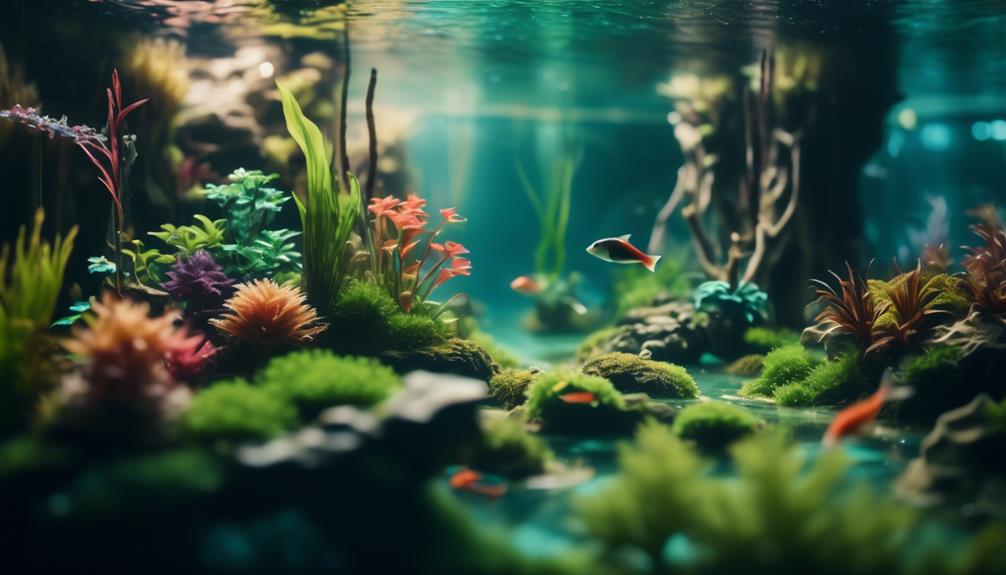
When setting up your rasbora aquarium, it’s important to consider a few key tips to ensure the optimal environment for these fascinating fish.
First, make sure to provide a medium-sized aquarium, at least 30 gallons, to accommodate their need for open swimming spaces.
It’s also crucial to choose suitable tank mates such as tetras, danios, white cloud minnows, plecos, and platys.
Next, create a well-planted tank with plenty of hiding spots using aquarium plants. Rasboras prefer subdued lighting, so consider adding floating plants to provide shade.
Maintain water conditions with a pH level between 6.0 and 7.0 and a temperature range of 75-80°F.
Lastly, provide them with a balanced diet consisting of flake-based foods and occasional live foods like blood worms or tubifex worms.
Frequently Asked Questions
How Do I Determine the Gender of a Rasbora Fish?
To determine the gender of a rasbora fish, look for physical differences. Females have rounded bodies, while males are slimmer. This can help you identify the male and female rasboras in your aquarium.
What Types of Live Foods Can I Feed My Rasboras?
You can feed your rasboras a variety of live foods, such as blood worms and tubifex worms. It’s important to provide them with proper nutrition for their health and well-being.
Can Rasboras Be Kept in a Community Tank With Aggressive Fish?
Yes, rasboras can be kept in a community tank with aggressive fish, but it’s important to choose suitable tank mates. Tetras, danios, white cloud minnows, plecos, platys, sword-tails, guppies, and mollies are good options.
How Often Should I Clean the Aquarium for Rasboras?
You should clean the aquarium for rasboras once a week. Regular maintenance is important for their health and well-being. This includes removing debris, changing water, and cleaning the filter to ensure a clean and stable environment.
Are There Any Specific Water Parameters That Rasboras Require?
Rasboras require specific water parameters for optimal health. They thrive in slightly acidic to neutral pH levels (6.0-7.5), with a temperature range of 72-82°F. Good water quality and regular water changes are essential for their well-being.
What Makes Rasboras and Corydoras Catfish Fascinating Aquarium Fish?
Rasboras and Corydoras catfish are popular choices for aquarium enthusiasts due to their peaceful nature and vibrant colors. The fascinating world of corydoras catfish, known for their playful behavior and unique swimming patterns, adds an extra element of intrigue to any aquarium setting.
Conclusion
In conclusion, Rasboras are truly captivating fish that bring beauty and joy to any aquarium. With their peaceful temperament, vibrant colors, and adaptability to various water conditions, they’re a great choice for both beginner and experienced aquarists.
By providing proper care, suitable tank mates, and a well-balanced diet, you can enjoy the company of Rasboras for up to ten years. So why wait? Dive into the enchanting world of Rasboras and experience the wonders they have to offer.




